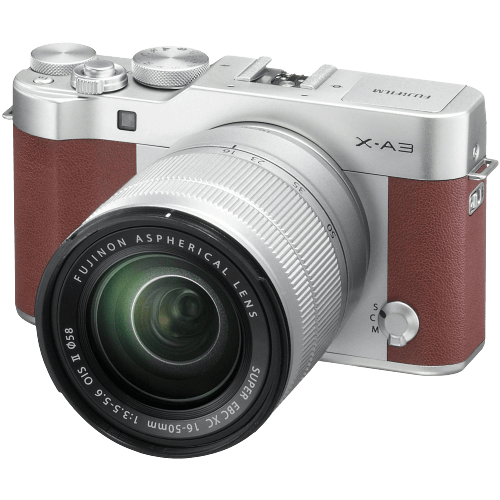Fujifilm X-A3 Specs and Scores

Scoring a 59/100, the Fujifilm X-A3 is a mirrorless camera announced on August 25, 2016. Priced at $599 during its release, this camera measures 117 x 67 x 40mm and weighs 339g (0.75lbs). Considering its age and specifications, the X-A3 still holds up decently in today’s market. However, newer models may offer more advanced features and better performance.
Fujifilm X-A3 Overview and Optics
The Fujifilm X-A3 receives a score of 63 out of 100 in the optics category. This camera offers 24 megapixels, a shooting speed of 6 frames per second, and a CMOS sensor. It is equipped with an EXR Processor II and has an APS-C sensor size. The lens mount is compatible with Fujifilm X lenses, but the camera lacks image stabilization. Its aspect ratio is 3:2.
Despite the absence of a DXOMARK score for this camera, the X-A3’s specifications provide a solid foundation for capturing high-quality images. The 24-megapixel count ensures detailed photographs, while the 6 fps shooting speed allows for capturing fast-moving subjects. The APS-C sensor size is a standard in the market, offering a good balance between size and image quality.
However, the lack of image stabilization may be a drawback for some users, especially when shooting in low light conditions or with longer focal lengths. In the competitive world of digital cameras, the Fujifilm X-A3 holds its ground in terms of optics but may not stand out from the crowd.
Fujifilm X-A3 Video Performance
The Fujifilm X-A3’s video capabilities receive a score of 56 out of 100. This camera offers Full HD video resolution, with maximum dimensions of 1920 x 1080 pixels. It can record at a maximum frame rate of 60fps, which provides smooth, high-quality footage. However, it lacks built-in time-lapse functionality, which may be a drawback for some users.
In today’s market, the X-A3’s video specifications are decent but not exceptional. Many modern cameras now offer 4K video resolution, which surpasses the Full HD offered by the X-A3. The absence of built-in time-lapse functionality also places the X-A3 behind some competitors.
The Fujifilm X-A3 has satisfactory video capabilities, but it does not stand out in this area when compared to other cameras in the market. It is suitable for casual video recording but may not meet the needs of those seeking advanced video features.
Fujifilm X-A3 Features and Benefits
The Fujifilm X-A3 has a feature score of 57 out of 100, which is a decent rating for a camera in today’s market. The camera is equipped with a 3-inch screen that has a resolution of 1,040,000 dots, ensuring clear and detailed image display. Also, the screen is a touchscreen, making it easy for users to navigate through the camera settings and features.
One of the standout features of the X-A3 is its flip screen, which is useful for capturing images from various angles and for taking selfies. However, the camera does not have built-in GPS, which might be a drawback for some users who want to geotag their photos. On the other hand, the X-A3 does have WiFi capability, allowing users to transfer images to their devices and share them on social media platforms easily. The absence of Bluetooth connectivity might be a downside for some, but the WiFi feature compensates for this limitation.
The Fujifilm X-A3 offers a set of useful features that cater to the needs of many photographers. The camera’s touchscreen, flip screen, and WiFi capabilities add value and make it a strong competitor in the market.
Fujifilm X-A3 Storage and Battery
The Fujifilm X-A3 scores 24/100 in storage and battery. The camera has one memory card slot and accepts SD, SDHC, and SDXC cards. With a battery life of 410 shots, it uses an NP-W126S battery type. However, the X-A3 does not support USB charging.
In comparison to other cameras in today’s market, the storage and battery specifications of the Fujifilm X-A3 are not impressive. A single memory card slot and lack of USB charging limit its convenience for users who need more storage or frequent charging options.
Considering the storage and battery aspects, the Fujifilm X-A3 falls short in meeting the demands of modern photography enthusiasts. Improvements in these areas could make it a more competitive option in the market.
